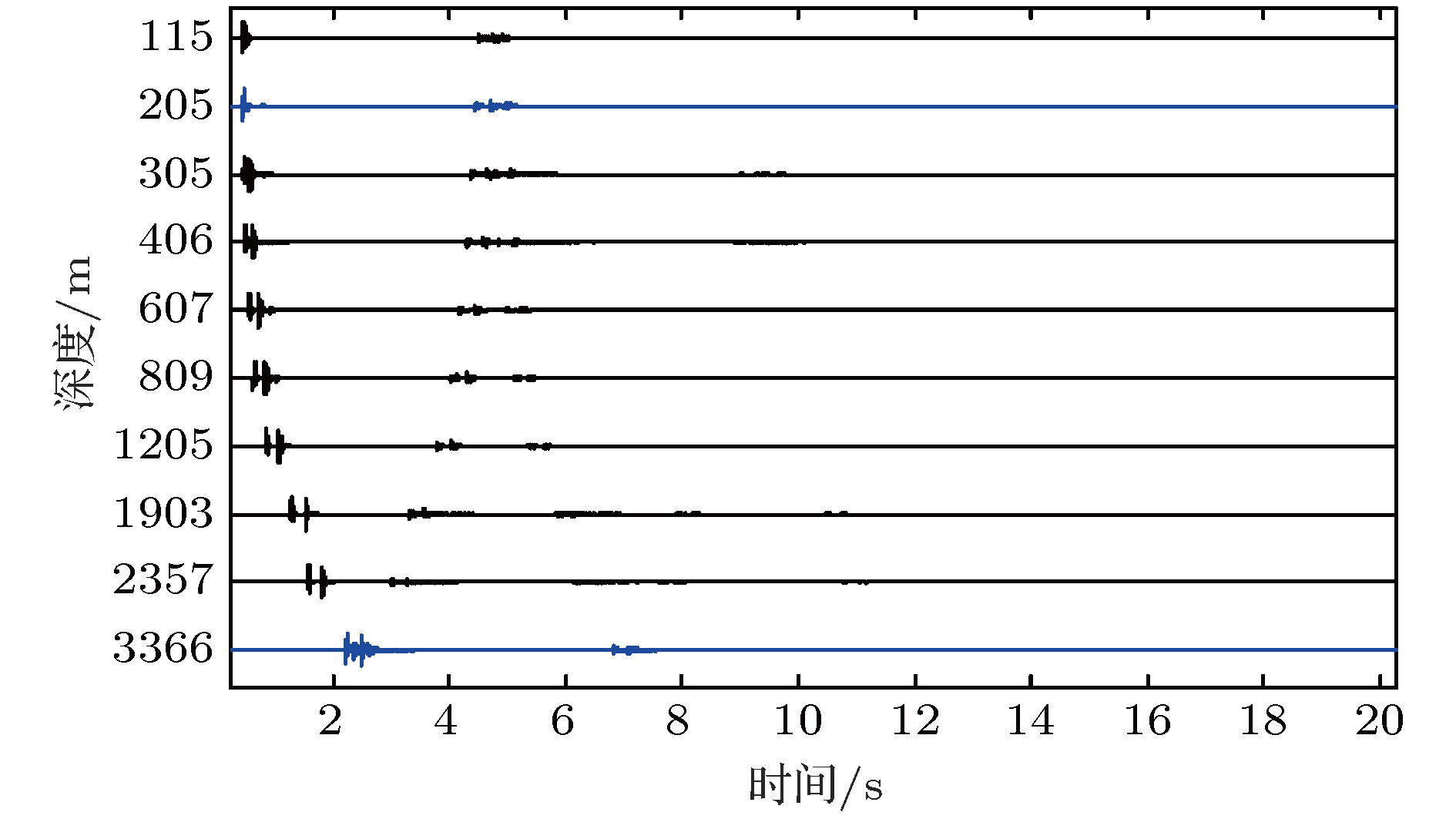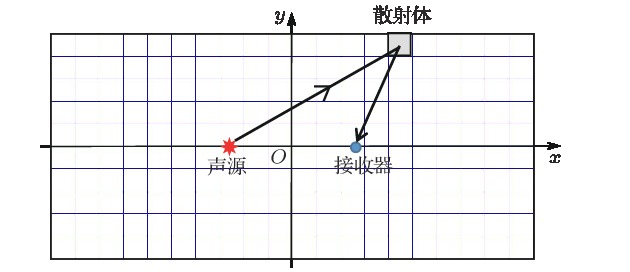-
Ocean reverberation is an important issue in underwater acoustics, which usually influences the working performance of the active sonars significantly. The deep-water reverberation data are collected from the South China Sea experiment including the reverberation signals at large receiving depths near the bottom, showing that the wave intensity increases obviously at some moments with time increasing. To analyze in depth the data, a uniform bottom-reverberation model is proposed based on the ray theory, which can calculate monostatic and bistatic reverberation intensity and explain the generation process of deep-water reverberation. The mesh method is first used in this model by dividing bottom scatterers into a number of grids. Then reverberation is calculated based on the exact time of generating the scattering signal from each grid. Due to the exact arrival time, the presented model can provide more accurate result than classical models, in which scatterers are usually treated as circular rings or elliptical rings. Numerical results are compared with experimental reverberations at different receiving distances and depths. The simulated and experimental results agree well overall for large receiving depths, whereas agreement extent decreases for the case of receiving depth close to the sea surface. The analytical results indicate that the applied scattering coefficient is suitable for this experimental sea area, and meanwhile verify that this scattering model is more accurate for low-angle bottom backscatters corresponding to the reverberation at large receiving depths.
-
Keywords:
- bottom reverberation /
- deep water /
- large receiving depth /
- ray theory
[1] Bucker H P, Morris H E 1968 J. Acoust. Soc. Am. 44 827
 Google Scholar
Google Scholar
[2] Zhang R H, Jin G L 1987 J. Sound Vib. 119 215
[3] Ellis D D 1995 J. Acoust. Soc. Am. 97 2804
 Google Scholar
Google Scholar
[4] Franchi E R, Griffin J M, King B J 1984 Naval Research Laboratory Washington DC, Report 8721
[5] Weinberg H 1982 OCEANS 82 Washington, DC, USA, September 20-22, 1982 p201
[6] 吴承义 1979 声学学报 02 114
Wu C Y 1979 Acta Acust. 02 114
[7] Lupien V H, Bondaryk J E, Baggeroer A B 1995 J. Acoust. Soc. Am. 98 2987
[8] Collins M D, Evans R B 1992 J. Acoust. Soc. Am. 91 1357
[9] McDaniel S T 1992 J. Acoust. Soc. Am. 91 31
[10] 李风华, 金国亮, 张仁和 2000 中国科学A辑 30 560
 Google Scholar
Google Scholar
Li F H, Jin G L, Zhang R H 2000 Sci. China Ser. A 30 560
 Google Scholar
Google Scholar
[11] 刘建军, 李风华, 郭良浩 2004 声学学报 49 56
Liu J J, Li F H, Guo L H 2004 Acta Acust. 49 56
[12] 刘建军, 李风华, 张仁和 2006 声学学报 31 173
 Google Scholar
Google Scholar
Liu J J, Li F H, Zhang R H 2006 Acta. Acust. 31 173
 Google Scholar
Google Scholar
[13] 吴金荣, 孙辉, 黄益旺 2002 哈尔滨工程大学学报 23 4
 Google Scholar
Google Scholar
Wu J R, Sun H, Huang Y W 2002 J. Harb. Engi. Univ. 23 4
 Google Scholar
Google Scholar
[14] Mackenzie K V 1961 J. Acoust. Soc. Am. 33 1498
 Google Scholar
Google Scholar
[15] Urick R J, Saling D S 1962 J. Acoust. Soc. Am. 34 1721
 Google Scholar
Google Scholar
[16] Ellis D D, Haller D R 1987 J. Acoust. Soc. Am. 82 S124
[17] Ellis D D, Crowe D V 1991 J. Acoust. Soc. Am. 89 2207
 Google Scholar
Google Scholar
[18] Williams K L, Jackson D R 1998 J. Acoust. Soc. Am. 103 169
 Google Scholar
Google Scholar
[19] 翁晋宝, 李风华, 刘建军 2014 中国声学学会全国声学学术会议 p67
Weng J B, Li F H, Liu J J 2014 National Acoustics Academic Conference of ASC Shanghai p67 (in Chinese)
[20] 郭熙业, 苏绍璟, 王跃科 2009 声学技术 28 203
 Google Scholar
Google Scholar
Guo X Y, Su S J, Wang Y K 2009 Tech. Acou. 28 203
 Google Scholar
Google Scholar
[21] Xu L Y, Yang K D, Guo X L 2016 Oceans Shanghai p1
[22] Yang K D, Xu L Y, Yang Q L, Li G X 2018 Acoust. Australia 46 131
 Google Scholar
Google Scholar
[23] Jackson D R, Briggs K B 1992 J. Acoust. Soc. Am. 92 962
 Google Scholar
Google Scholar
-
图 10 数值模拟的大接收深度混响强度与实验结果对比. 声源频率500 Hz, 图中蓝色曲线为实验结果, 红色曲线为数值模拟结果. (a) 收发相距0.76 km, 接收深度1903 m; (b) 收发相距0.76 km, 接收深度3366 m; (c) 收发相距3.19 km, 接收深度2306 m; (d) 收发相距3.19 km, 接收深度3366 m; (e) 收发相距5.45 km, 接收深度2357 m; (f) 收发相距5.45 km, 接收深度3366 m; (g) 收发相距7.75 km, 接收深度3021 m; (h) 收发相距7.75 km, 接收深度3366 m
Figure 10. Comparison of reverberation at large receiving depths between numerical simulations and experimental results. The source frequency is 500 Hz. In each subgraph, the blue curve denotes the experimental result, and the red curve indicates the numerical simulation result. The distance from source to receiver and the receiving depth is (a) 0.76 km and 1903 m, (b) 0.76 km and 3366 m, (c) 3.19 km and 2306 m, (d) 3.19 km and 3366 m, (e) 5.45 km and 2357 m, (f) 5.45 km and 3366 m, (g) 7.75 km and 3021 m, (h) 7.75 km and 3366 m.
图 11 接收器靠近海面时的混响强度. 声源频率500 Hz, 图中蓝色曲线为实验结果, 红色曲线为数值模拟结果; (a)收发相距0.76 km, 接收深度205 m; (b)收发相距7.75 km, 接收深度205 m
Figure 11. Reverberation for receiving depth near the sea surface. The source frequency is 500 Hz. In each subgraph, the blue curve denotes the experimental result, and the red curve indicates the numerical simulation result. The distance from source to receiver and the receiving depth is (a) 0.76 km and 205 m, (b) 7.75 km and 205 m.
-
[1] Bucker H P, Morris H E 1968 J. Acoust. Soc. Am. 44 827
 Google Scholar
Google Scholar
[2] Zhang R H, Jin G L 1987 J. Sound Vib. 119 215
[3] Ellis D D 1995 J. Acoust. Soc. Am. 97 2804
 Google Scholar
Google Scholar
[4] Franchi E R, Griffin J M, King B J 1984 Naval Research Laboratory Washington DC, Report 8721
[5] Weinberg H 1982 OCEANS 82 Washington, DC, USA, September 20-22, 1982 p201
[6] 吴承义 1979 声学学报 02 114
Wu C Y 1979 Acta Acust. 02 114
[7] Lupien V H, Bondaryk J E, Baggeroer A B 1995 J. Acoust. Soc. Am. 98 2987
[8] Collins M D, Evans R B 1992 J. Acoust. Soc. Am. 91 1357
[9] McDaniel S T 1992 J. Acoust. Soc. Am. 91 31
[10] 李风华, 金国亮, 张仁和 2000 中国科学A辑 30 560
 Google Scholar
Google Scholar
Li F H, Jin G L, Zhang R H 2000 Sci. China Ser. A 30 560
 Google Scholar
Google Scholar
[11] 刘建军, 李风华, 郭良浩 2004 声学学报 49 56
Liu J J, Li F H, Guo L H 2004 Acta Acust. 49 56
[12] 刘建军, 李风华, 张仁和 2006 声学学报 31 173
 Google Scholar
Google Scholar
Liu J J, Li F H, Zhang R H 2006 Acta. Acust. 31 173
 Google Scholar
Google Scholar
[13] 吴金荣, 孙辉, 黄益旺 2002 哈尔滨工程大学学报 23 4
 Google Scholar
Google Scholar
Wu J R, Sun H, Huang Y W 2002 J. Harb. Engi. Univ. 23 4
 Google Scholar
Google Scholar
[14] Mackenzie K V 1961 J. Acoust. Soc. Am. 33 1498
 Google Scholar
Google Scholar
[15] Urick R J, Saling D S 1962 J. Acoust. Soc. Am. 34 1721
 Google Scholar
Google Scholar
[16] Ellis D D, Haller D R 1987 J. Acoust. Soc. Am. 82 S124
[17] Ellis D D, Crowe D V 1991 J. Acoust. Soc. Am. 89 2207
 Google Scholar
Google Scholar
[18] Williams K L, Jackson D R 1998 J. Acoust. Soc. Am. 103 169
 Google Scholar
Google Scholar
[19] 翁晋宝, 李风华, 刘建军 2014 中国声学学会全国声学学术会议 p67
Weng J B, Li F H, Liu J J 2014 National Acoustics Academic Conference of ASC Shanghai p67 (in Chinese)
[20] 郭熙业, 苏绍璟, 王跃科 2009 声学技术 28 203
 Google Scholar
Google Scholar
Guo X Y, Su S J, Wang Y K 2009 Tech. Acou. 28 203
 Google Scholar
Google Scholar
[21] Xu L Y, Yang K D, Guo X L 2016 Oceans Shanghai p1
[22] Yang K D, Xu L Y, Yang Q L, Li G X 2018 Acoust. Australia 46 131
 Google Scholar
Google Scholar
[23] Jackson D R, Briggs K B 1992 J. Acoust. Soc. Am. 92 962
 Google Scholar
Google Scholar
Catalog
Metrics
- Abstract views: 16561
- PDF Downloads: 162
- Cited By: 0















 DownLoad:
DownLoad:










